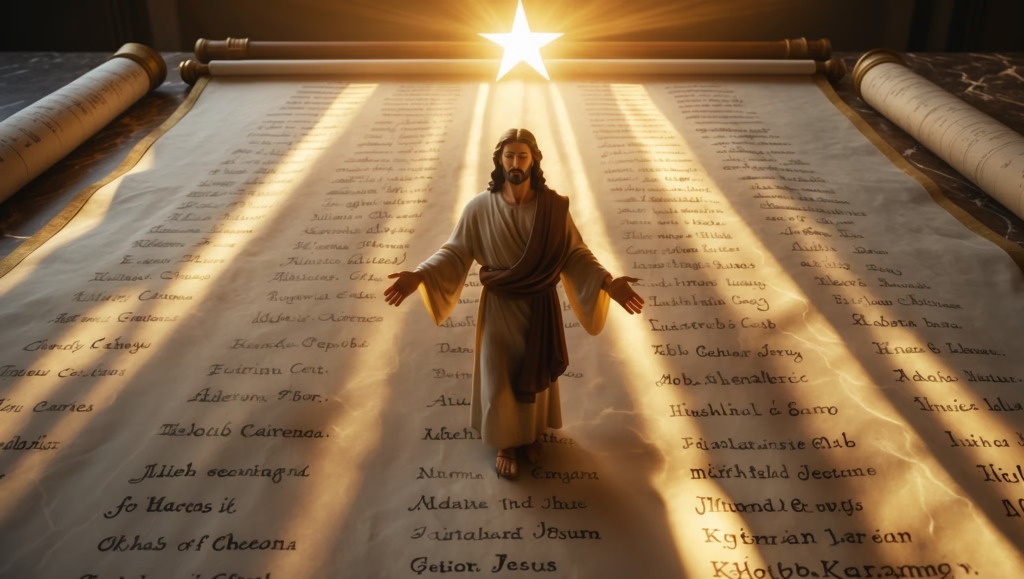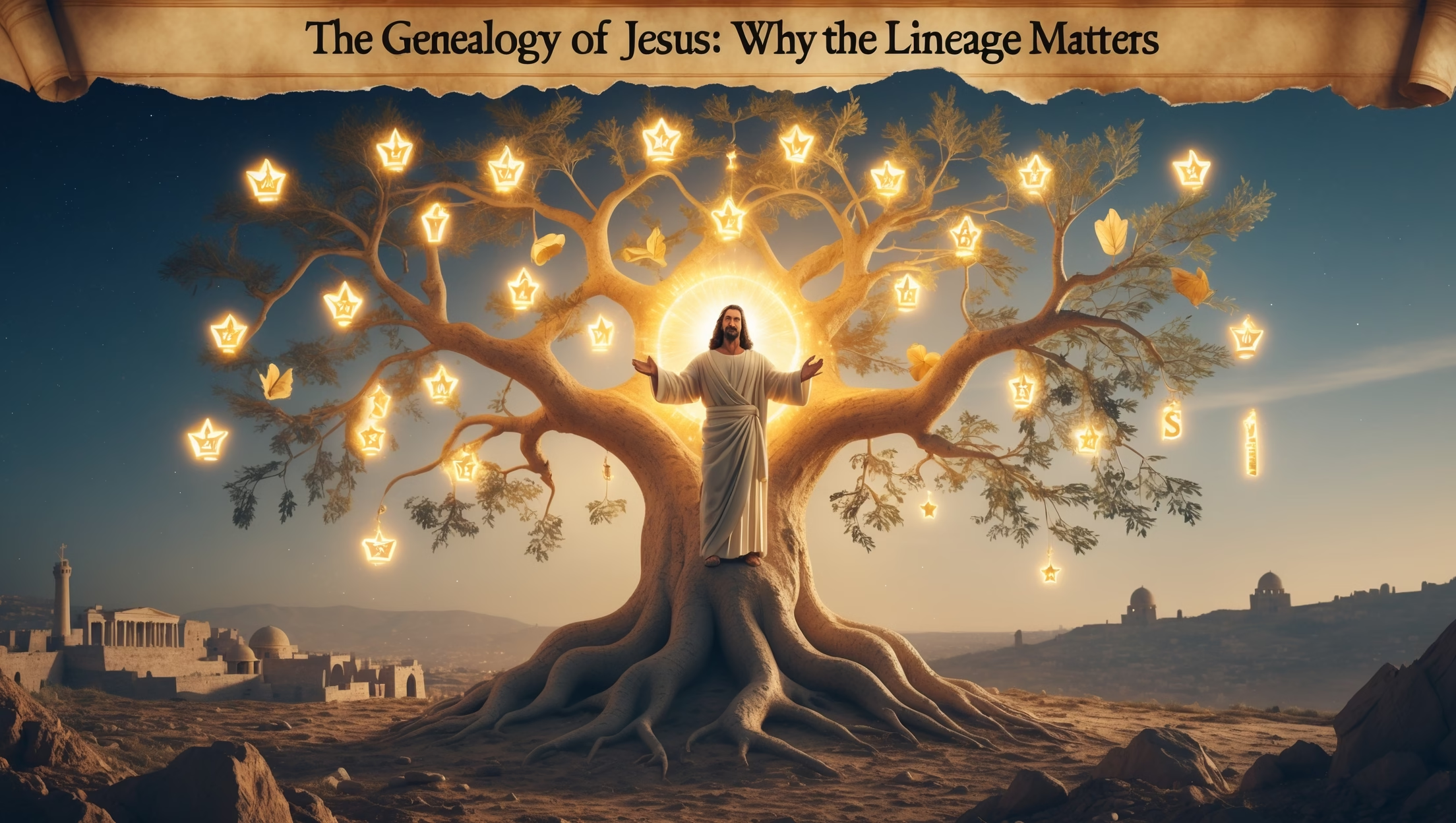Introduction
The genealogy of Jesus is one of the most intriguing yet often overlooked aspects of the Gospels. At first glance, it may appear as nothing more than a list of names—a series of fathers, sons, and generations recorded in ancient history. However, these genealogical records found in the Gospels of Matthew and Luke carry far greater significance than simple family documentation. They are not just historical details; they reveal profound theological truths about God’s faithfulness, His promises to Israel, and the universal scope of salvation through Christ.
The Jesus family tree is not merely about bloodlines but about God’s unfolding plan through human history. The Gospels show that Jesus stands at the center of a story that stretches back to the creation of humanity and extends forward to all nations. By exploring both Matthew’s and Luke’s accounts, as well as the unique inclusion of women in the genealogies and their connection to Old Testament prophecies, we discover why the lineage of Jesus matters—not only for biblical history but also for our personal understanding of faith today.

The Genealogy in Matthew
The Gospel of Matthew opens with a bold statement: “This is the genealogy of Jesus the Messiah, the son of David, the son of Abraham” (Matthew 1:1). From the very first verse, Matthew establishes that Jesus is the fulfillment of Israel’s long-awaited promises. By anchoring Jesus’ ancestry to Abraham, Matthew shows that Jesus is deeply rooted in the Jewish story—the covenant God made with Abraham to bless all nations through his descendants (Genesis 12:3).
Matthew structures his genealogy in three sets of fourteen generations: from Abraham to David, from David to the Babylonian exile, and from the exile to Christ. This deliberate arrangement underscores that Jesus is the climax of Israel’s history. The use of the number fourteen may also reflect a symbolic connection to the name “David” in Hebrew, which has a numerical value of fourteen. In other words, Matthew highlights Jesus as the true heir of King David, the rightful heir to the throne, and the one who fulfills the Jesus prophecy fulfillment regarding the Messiah’s royal lineage.
By doing this, Matthew reminds his Jewish audience that Jesus is not an outsider or a radical break from their tradition but rather the culmination of God’s covenant promises. He is both the seed of Abraham, through whom the world would be blessed, and the son of David, the King whose throne would endure forever.
The Genealogy in Luke
While Matthew emphasizes Jesus’ Jewish and royal credentials, the Gospel of Luke takes a different approach. Luke traces the Jesus lineage not just to Abraham but all the way back to Adam, the very first human being. In doing so, Luke presents Jesus not only as the Messiah for Israel but as the Savior for all humanity.
By ending the genealogy with Adam, Luke situates Jesus as the “Son of Man” who represents every person who has ever lived. The message is universal: salvation through Christ is not limited to the Jewish people but is extended to Gentiles and all nations. Luke’s genealogy highlights Jesus’ humanity, reminding readers that the Son of God entered into the full human story, identifying with every weakness and experience of mankind.
In this way, Luke provides a cosmic dimension to the Jesus family tree. It connects the Savior not only to the story of Israel but to the broader story of creation itself. Jesus is the new Adam—the one who comes to reverse the fall, to restore what was broken, and to bring redemption to all people across the earth.
Women in the Genealogy
One of the most striking features of Matthew’s genealogy is the inclusion of women. In ancient Jewish genealogies, it was uncommon to highlight female ancestors, yet Matthew deliberately includes four: Tamar, Rahab, Ruth, and Bathsheba. Each of these women carries a unique and complex story, and their inclusion is a powerful theological statement.
Tamar’s story involves brokenness and injustice, Rahab was a Canaanite prostitute who showed faith, Ruth was a Moabite widow whose loyalty led her into Israel’s family, and Bathsheba was connected to David through a scandalous affair. Yet, despite their unlikely backgrounds, these women became vital parts of the Jesus ancestry. Their stories testify to God’s ability to work through the marginalized, the outsider, and the broken to accomplish His redemptive purposes.
By including these women, Matthew reminds us that the Messiah’s lineage was not one of flawless perfection but of grace. God intentionally wove their lives into the royal line to demonstrate that His plan includes those whom society might overlook or dismiss. The genealogy of Jesus thus becomes a testimony of God’s mercy and inclusiveness.
Fulfillment of Prophecy
The genealogies also serve to confirm the fulfillment of Old Testament prophecies. The prophets had long declared that the Messiah would come from the line of David, and both Matthew and Luke ensure their readers see this connection. For example, Jeremiah 23:5 foretells a “righteous Branch” from David’s line who would reign as king, and Isaiah 11:1 speaks of a shoot coming from the stump of Jesse (David’s father).
By presenting Jesus as a descendant of David, the Gospel writers affirm that He is not merely a spiritual leader but the rightful King who fulfills these ancient prophecies. This Jesus prophecy fulfillment strengthens the faith of believers, showing that God’s promises through the centuries were not forgotten but realized in Christ.
Furthermore, the genealogies highlight that God’s plan was never random. Every generation, every story, and every name was part of a larger design pointing toward the coming of the Messiah. For Christians today, this provides reassurance that God’s promises are reliable and that His plans for humanity unfold with divine precision.
Why It Matters for Us
It is easy to overlook genealogies as irrelevant lists of names, but the Jesus family tree holds profound meaning for our lives today. First, it reminds us that God works through history. He does not act in isolation but through the lives of real people, families, and generations. This means that our own lives, with all their complexities and imperfections, are not outside the reach of God’s plan.
Second, the genealogy of Jesus shows that no story is too broken for redemption. The inclusion of flawed individuals and unexpected figures highlights that God can use anyone to fulfill His purposes. Our past does not disqualify us from God’s work; instead, it becomes part of the testimony of His grace.
Third, the genealogies remind us of our place in God’s unfolding story. Just as the names in Jesus’ ancestry carried forward the promise of salvation, so too are we invited to be part of God’s mission in the world. Our choices, relationships, and faith can echo through generations to come.
Conclusion
The lineage of Jesus is more than a historical detail—it is a story of grace, promise, and fulfillment. Through Matthew’s genealogy, we see Jesus as the culmination of Israel’s covenant history and the royal heir of David. Through Luke’s genealogy, we see Jesus as the Savior of all humanity, connected to every person through Adam. The inclusion of women demonstrates God’s redemptive work through unexpected lives, while the fulfillment of prophecy affirms the reliability of God’s promises.
For us today, the genealogy of Jesus is a powerful reminder that God works through ordinary people, across generations, to accomplish extraordinary purposes. It assures us that our lives are not random but woven into God’s larger plan. Most importantly, it points us to Christ as the true King, the promised Messiah, and the Savior of the world.
The Jesus lineage is therefore not just about where He came from, but about what His coming means for us. It invites us to see ourselves as part of the same story—one of grace, hope, and eternal promise.








